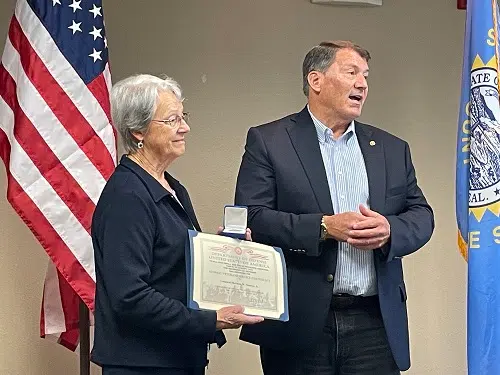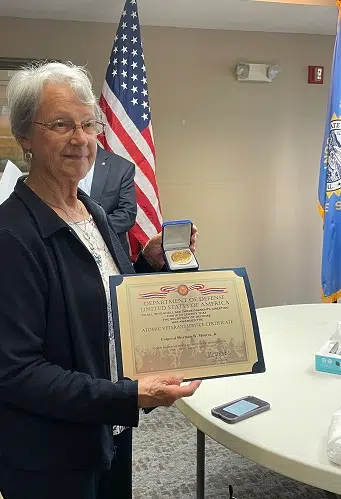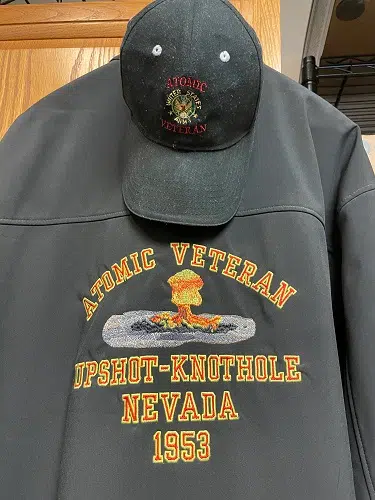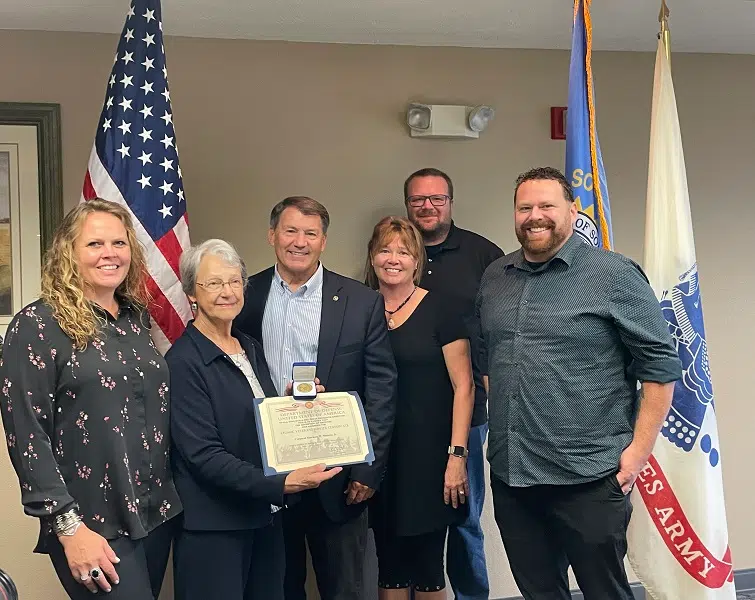A veteran from Pierre was posthumously recognized this morning (Sept. 15, 2023) for his service during the Korean War.
South Dakota US Senator Mike Rounds presented the family of US Army Corporal Sherman W. Monroe, Jr., with his Atomic Veterans Commemorative Service Medal, prior to their leaving for Monroe’s burial this afternoon at the Black Hills National Cemetery at Sturgis.
This is a fairly new medal, so Rounds staff member Bob DeJong shared some information about it.
DeJong says Monroe’s service was part of “Operation Upshot-Knothole.”
At the time, there was a lot we didn’t know or understand about atomic bombs and Senator Rounds says we’re now in a similar situation with artificial intelligence technology.
A memorial service for Corporal Monroe will be held tomorrow (Sept. 16, 2023) at 10:30am the First Congregational United Church of Christ in Pierre.
About the medal:
On July 5, 2022, the SECDEF established the Atomic Veterans Commemorative Service Medal to commemorate the service and sacrifice of veterans who were instrumental in the development of our Nation’s atomic and nuclear weapons programs. Our Nation’s long-standing nuclear deterrence capability resulted from the service and sacrifice of Service members (now known as “Atomic Veterans”) who participated in the initial testing and development of our Nation’s atomic and nuclear weapons programs. Notably, the dangerous and important work these veterans performed was often done in secret due to national security requirements.
The Atomic Veterans Commemorative Service Medal recognizes that the service and sacrifice of the Atomic Veterans directly contributed to our Nation’s continued freedom and prosperity during the period following World War II, and was pivotal to our Nation’s defense during the Cold War era.
Veterans eligible for the medal are those who, while performing official military duties during the period of July 1, 1945, to October 1, 1992:
(1) directly participated in the detonation of an atomic weapon or device;
(2) directly participated in the cleanup of radioactive material resulting from any such atmospheric detonation;
(3) directly participated in the cleanup of radioactive material resulting from an accident associated with an atomic weapon; or
(4) were exposed to ionizing radiation resulting from the operational use of atomic weapons during World War II.
The Director of the Defense Threat Reduction Agency (DTRA) will manage the Department’s Atomic Veterans Commemorative Service Medal program.
Operation Upshot-Knothole:
Operation UPSHOT-KNOTHOLE, the ninth series of atmospheric nuclear tests, was conducted by the Atomic Energy Commission (AEC) at the Nevada Proving Ground (NPG) from March 17 to June 20, 1953. The series consisted of 11 nuclear tests. One detonation was an atomic artillery projectile fired from a 280mm cannon, three were airdrops, and seven were detonated on towers ranging from 100 to 300 feet in height. The operation involved an estimated 20,100 Department of Defense (DOD) personnel participating in observer programs, tactical maneuvers, scientific studies, and support activities. UPSHOT-KNOTHOLE was intended to test nuclear devices for possible inclusion in the U.S. arsenal; to improve military tactics, equipment, and training; and to study civil defense needs.
Johnson served in the United States Marine Corps from 4 January 1952 through 3 January 1955. In 1953, while stationed at Camp Pendleton, California, with the 3rd Marine Division, his unit went to Nevada Proving Grounds where his unit participated in Camp Desert Rock V and was billeted at Camp Desert Rock. Johnson says his unit was bussed out to trenches approximately 4000-5000 meters from the detonation site. Once detonation was complete, unit members walked towards the detonation site until the dosimeter (radiation level) ratings reached a certain level. Once radiation levels got so high, unit members were directed to turn around and head back to Camp Desert Rock.

Sherman Monroe, Jr.’s wife Vivian accepts his Atomic Veterans Commemorative Service Medal from South Dakota Senator Mike Rounds.
Photo credit Jody Heemstra, DRG Media Group.

Sherman Monroe, Jr.’s wife Vivian accepts his Atomic Veterans Commemorative Service Medal from South Dakota Senator Mike Rounds.
Photo credit Jody Heemstra, DRG Media Group.

Photo credit Jody Heemstra, DRG Media Group.

Part of Sherman Monroe, Jr.’s family.
Photo credit Jody Heemstra, DRG Media Group.









Comments